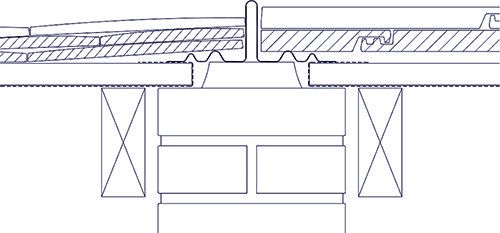
There are various forms of bonding gutter, but essentially they are all used for the same purpose; to weather a junction between differing roof coverings – for example, between double lapped plain tiles and single lap tiles. The most common situation is where an old roof is replaced on a semi-detached or terraced house and the junction between the new roof and an existing neighbouring roof needs to be weathered (i.e. sealed).
The wrong way of weathering the junction between roof coverings is to finish the new tiling close to the neighbouring tiling and then mortar-bed some form of covering over the joint, for example paving stones, copings or even a row of tiles. Although commonly done, this is rarely successful or adequate. The integrity of the joint relies on the mortar bedding, so even if it is waterproof to start with, it will inevitably start to leak as soon as any small cracks appear in the mortar bed.
The correct way to weather the junction is to install some form of gutter, or channel, between the different tiling. This can be formed from lead or be a manufactured, pre-formed product.
Diagram 1 shows a typical bonding gutter detail using a lead-lined drainage channel at the junction between the two roof coverings. In this detail, the lead lining carries over vertical battens, finishing in welts at each side. By limiting the gap between the two roof coverings to no more than 15mm, there is no need to use mortar to close the gaps between the tiles to prevent access to birds and rodents.
Another option is to use a preformed bonding gutter lining with upstands either side to direct water towards the gutter. Some of these have an open channel for the water, with the tiles mortar-bedded onto each side, or, as is the case in diagram 2, the edge tiles are bedded onto the centre of the gutter.
An increasingly popular form of bonding gutter is a pre-formed one with a central upstand. The advantage of this type is that there is no need for any mortar bedding. The gutter is easier to install as it simply sits over the tile battens and firebreak, if installed. The tiles at either side are finished close to the upstand to close the gap between the tiles – see diagram 3.
When installing the tiles abutting the bonding gutter it may be necessary to remove tile nibs to enable the tiles to sit close over the bonding gutter upstands. It is also a good idea to use screws to secure the edge tiles, making sure the fixings do not penetrate the gutter lining, of course. Screws make it easier to pull the tiles closer to the battens, further reducing the amount of possible ‘kicking’ over the gutter upstands.
One of the most common problems with bonding gutters is not actually related to the technical installation at all; they are very often the cause of disputes between neighbours. Bonding gutters are normally positioned over the party wall between properties, combining with a firebreak detail, but this does not necessarily have to be the case.
It’s good to talk
My strong advice to anyone about to install a new roof adjoining a neighbour’s roof is to first talk to the neighbour to explain and agree the installation process. This is important because half of the bonding gutter will be on the neighbour’s side of the roof. The alternative option is to position the bonding gutter so that it is wholly on the side of the roof being renewed. This means that there is no encroachment onto the neighbour’s side and so there are no grounds for dispute. This is particularly easy to do for bonding gutters that sit over the tile battens, such as those shown in diagrams 2 and 3, as there is no need for any additional structure support for the bonding gutter lining.






